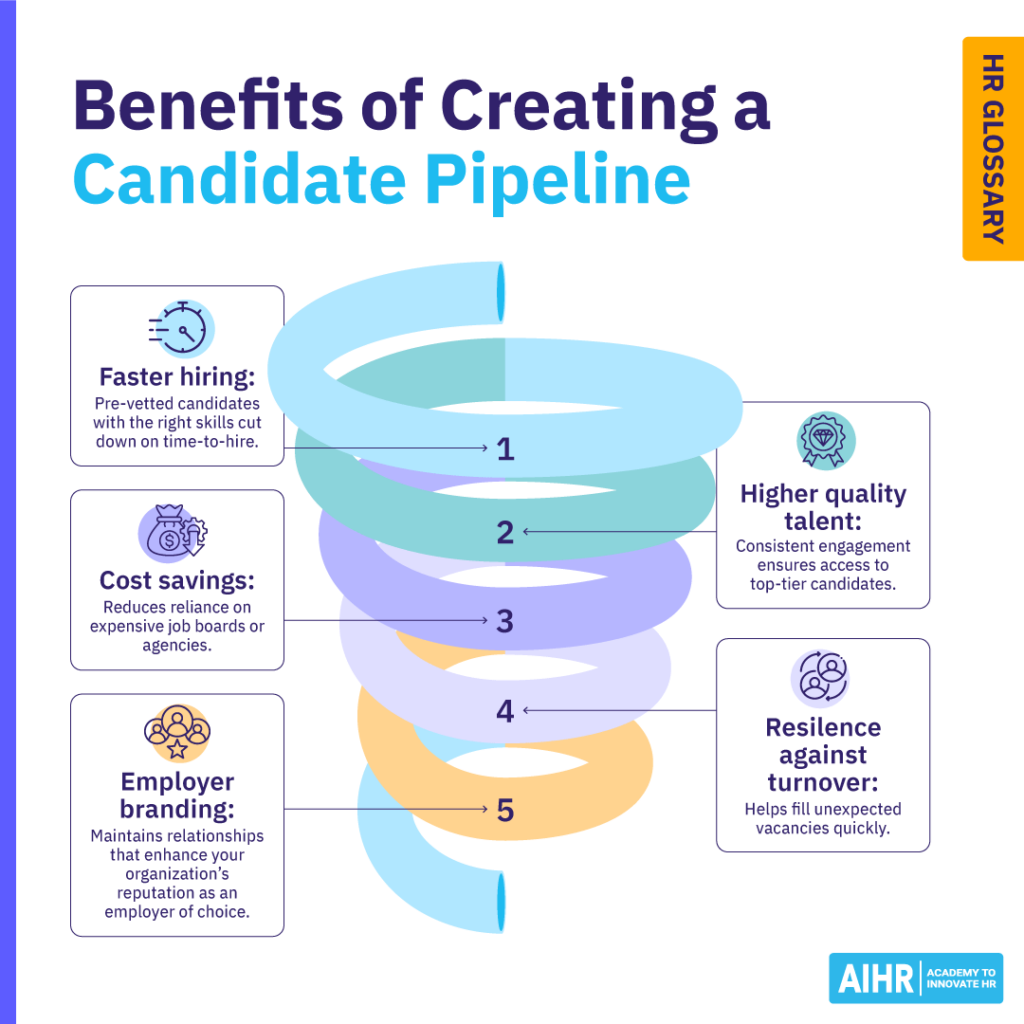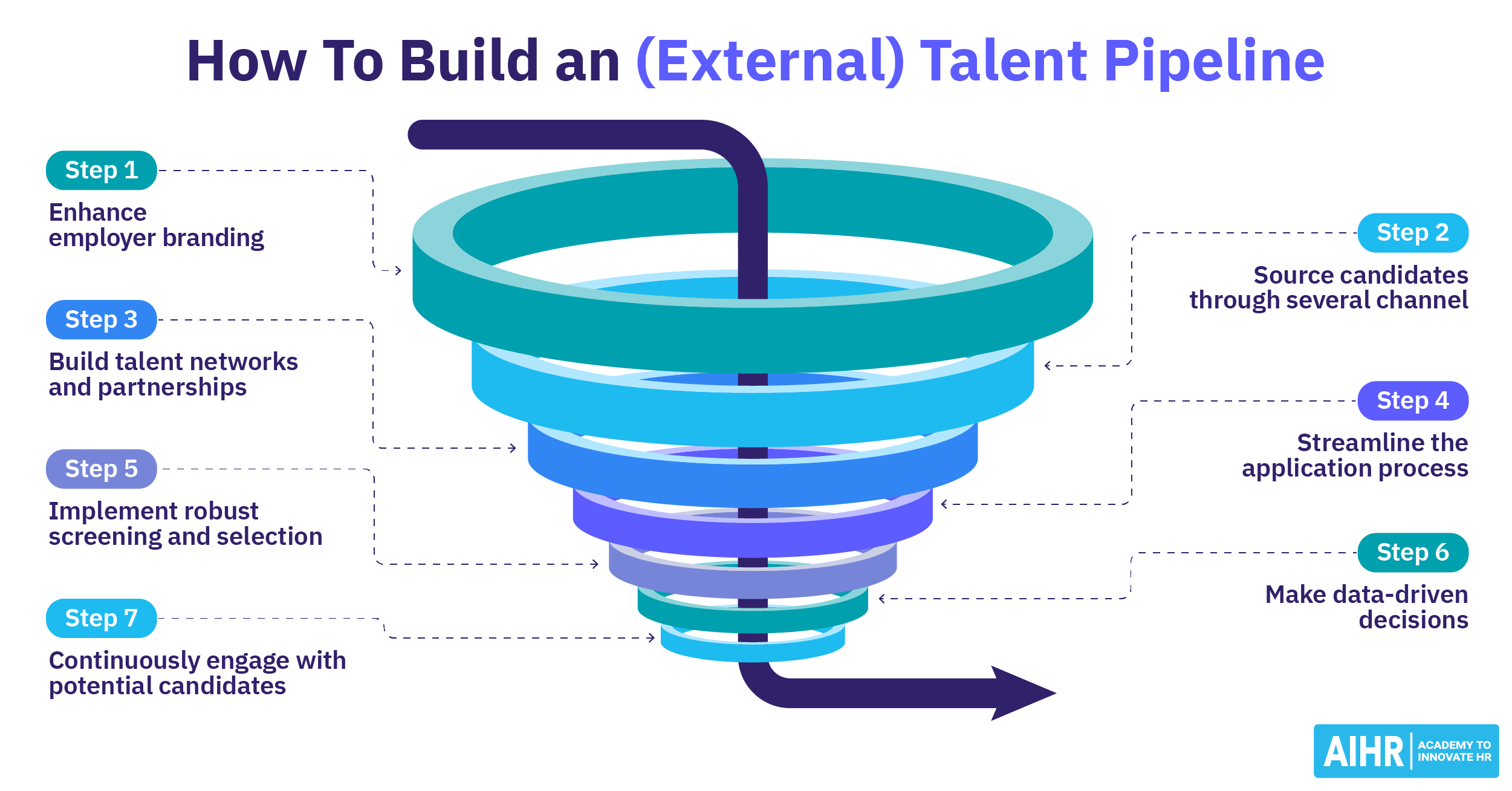Candidate Pipeline
What is a candidate pipeline?
A candidate pipeline is a list of pre-qualified applicants who may be suitable for current or future positions in an organization. It can consist of various individuals, such as past applicants, internal employees, professional connections, or employee referrals.
HR professionals responsible for candidate pipeline development create and manage this list as part of their recruitment strategy. A well-developed pipeline can help you quickly fill critical roles, a valuable asset in a competitive job market.
Why is building a candidate pipeline important?
Developing a candidate pipeline is an essential part of your recruitment strategy for the following reasons:
- Reduced time to hire: A list of previously vetted candidates with the right skills can considerably reduce time to hire. These candidates can be more easily shortlisted and interviewed compared to new applicants.
- Improved quality of hire: By consistently engaging with top talent, organizations can ensure they have access to skilled candidates who align with their needs.
- Lower hiring costs: A proactive approach to talent sourcing minimizes reliance on expensive recruitment methods like job boards or external agencies.
- Resilience against turnover: Having a reliable candidate pipeline ensures the organization isn’t caught off guard by unexpected vacancies or turnover.
- Better employer branding: Building and maintaining relationships with potential candidates showcases the organization as proactive and attractive, enhancing its reputation as an employer of choice.

Candidate pipeline vs. talent pool
Although a candidate pipeline and a talent pool are both examples of a strategic approach to talent management, there are some key differences between them:
Definition
A group of pre-qualified candidates actively nurtured for specific future roles.
A broader collection of potential candidates with various skills and experience, not necessarily tied to particular roles.
Purpose
To fill certain roles quickly by having ready-to-hire candidates.
To serve as a resource for various roles, particularly when needs are less immediate.
Qualifications
Pre-screened and shortlisted for their desirable skills.
May or may not be qualified for specific roles.
Motivation
Highly motivated, as they have previously expressed an interest or applied for a position.
Varying levels of motivation, as talent may have not previously engaged with the organization.
Recruitment process
Typically shorter because candidates have been previously vetted.
Longer, as candidates still need to go through screening and interviewing.
Candidate pipeline tools
Candidate pipeline development can be time-consuming, but these tools can help you reduce time and effort:
- LinkedIn Recruiter: This allows you to source, track, and engage candidates using LinkedIn’s vast professional network and is especially effective for passive candidates.
- Lever: Combining CRM and ATS functionalities, Lever helps recruiters nurture relationships with potential hires and provides robust pipeline analytics.
- Workable: An ATS that can assign candidates to specific roles, categorizing their skills, experience, and suitability for specific open positions. Workable accommodates detailed profiles with previous interview notes and assessment results, helping to evaluate candidates’ current readiness for different roles.
- Jobvite: Jobvite is an ATS that offers intelligent text messaging tools with 98% open rates. It can be used to engage and maintain contact with top talent in your candidate pipeline.
Learn the skills you need to build a robust candidate pipeline
To ensure a reliable candidate pipeline for your organization, you must proactively source, engage, and maintain relationships with diverse talent pools while using effective recruitment strategies and employer branding.
In AIHR’s Sourcing and Recruitment Certificate Program, you’ll learn to source and engage passive candidates and build an influential employer brand.
This online, self-paced Certificate Program will also teach you how to use effective screening techniques and tools, including best practices for screening and reference calls.
How can HR build a candidate pipeline?
Developing a robust candidate pipeline can be mastered by following these essential steps:
- Identify pipeline positions: Identify roles you regularly hire for or those critical to future growth. This will allow you to focus on sourcing candidates with the required skills and experience.
- Organize talent pools: Create segmented lists of pre-qualified and pre-screened candidates based on job functions, skills, and experience that could match open or future roles. Use ATS tools to track and update candidate information over time.
- Source continuously: Tap into job boards, LinkedIn, industry forums, and niche communities regularly, not just when positions open up. Engage passive candidates who might be interested down the line.
- Pre-qualify all candidates: Determine the suitability of new candidate sources through a regular pre-employment screening process (e.g., reviewing résumés and online profiles, short phone interviews, and background checks).
- Nurture candidate relationships: Stay in touch with high-quality candidates, cultivating a relationship with each one. Share company news and open positions through regular email newsletters, social media, and professional events.
- Evaluate the quality of the candidate pipeline: Regularly review its effectiveness by analyzing key metrics like candidate engagement and satisfaction, time to hire, and quality of hire.
HR tip
Consider developing and nurturing a passive candidate pipeline—a list of highly skilled individuals not actively searching for a new job. Passive candidates may be open to new opportunities if presented with a compelling offer. Building such a pipeline requires personalized outreach through professional networks, social media, industry events, or targeted searches, making it especially useful for hard-to-fill roles.
FAQ
Candidate pipeline management involves identifying, assessing, and engaging a pool of qualified candidates who may be suitable for future job opportunities. It’s an active process that involves maintaining communication, nurturing relationships, and continuously assessing candidates’ interests and suitability.
A candidate pipeline can help organizations find qualified candidates to fill roles quickly, reducing time to hire and improving hiring quality. Having a well-developed pipeline can give organizations a significant advantage in a competitive job market.








